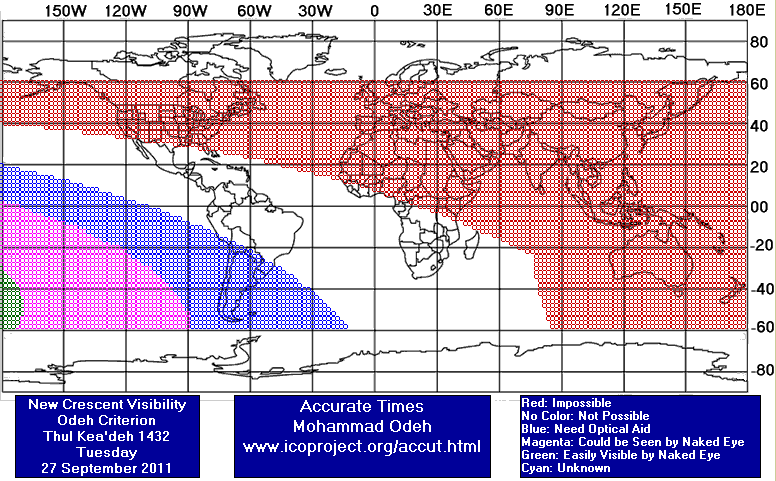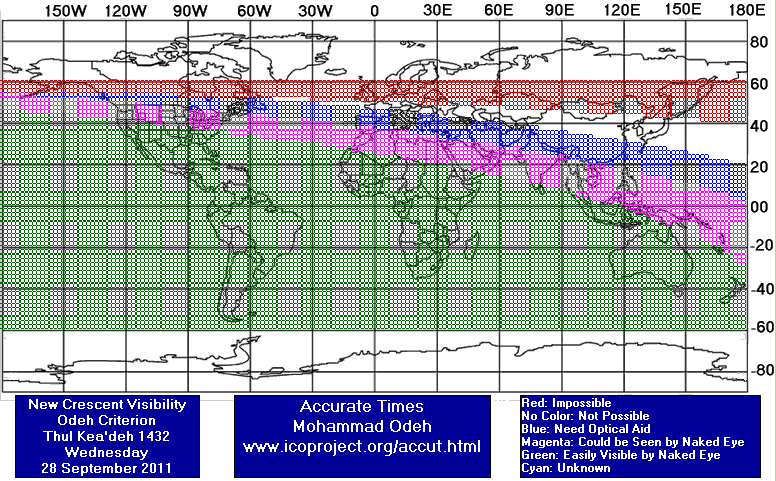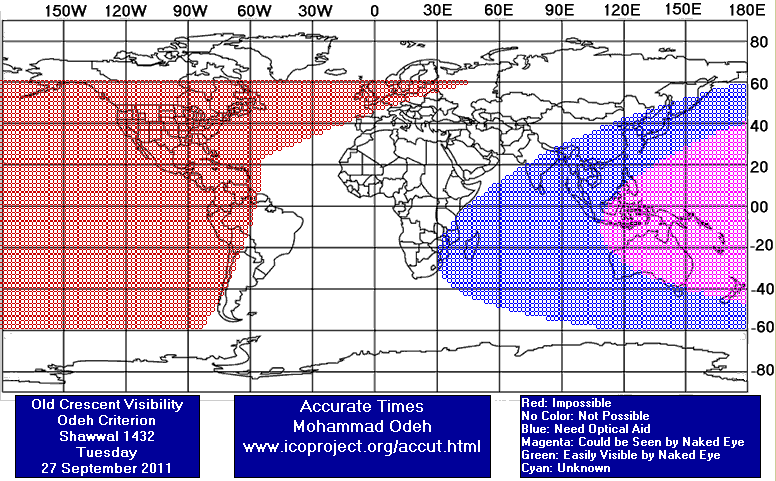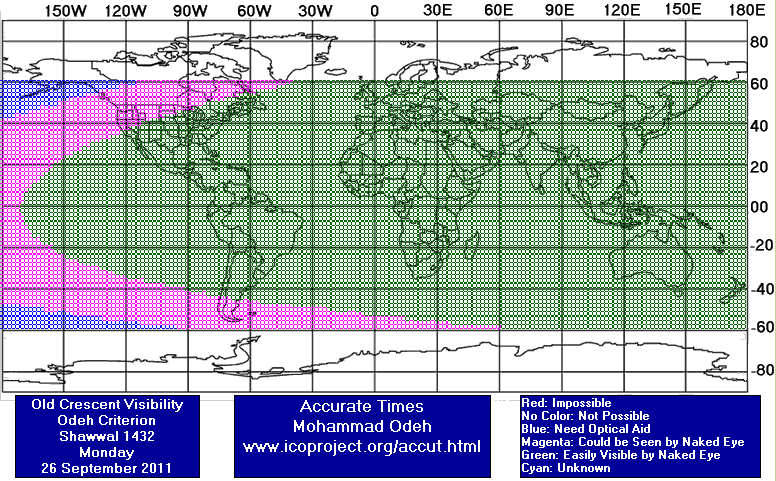Visibility of Dhul Qeadah Crescent 1432 AH
- When to Observe Dhul Qeadah Waxing (NEW) Crescent ?
- Dhul Qeadah Waxing (NEW) Crescent Observation Results
- The OFFICIAL First Day in Different Countries
- When to Observe Shawwal Waning (OLD) Crescent ?
- Shawwal Waning (OLD) Crescent Observation Results
When to Observe Dhul Qeadah Waxing (NEW) Crescent ?
The geocentric conjunction (Geocentric New Moon) will occur Inshalla on (Tuesday 27 September 2011) at 11:09 UT.
Sighting the new crescent on (Tuesday 27 September 2011) and (Wednesday 28 September 2011) is shown in the below graphs using the program Accurate Times by Mohammad Odeh according to Odeh criterion. Where:-
- It is impossible to see the crescent from the areas located under the red color. Because either the Moon on this day sets before the Sunset and/or the topocentric conjunction occurs after the Sunset.
- The crescent is expected to be seen by optical aid only from the areas located under the blue color.
- The crescent is expected to be seen by optical aid from the areas located under the magenta color. In these areas the crescent could be seen by naked eye if the atmospheric conditions are superb and the observer is experienced.
- The crescent is expected to be easily visible by naked eye from the areas located under the green color.
- The crescent cannot be seen from uncolored areas, even though the Moon sets in these locations after the Sunset and the topocentric conjunction occurs before the Sunset, but the Moon is not sufficiently illuminated in order to be seen as crescent even by optical aid.
- Kindly notice that the below graph shows the possibility of seeing the crescent from areas between 60 degrees north of Equator down to 60 degrees south of Equator.


According to the Universal Hejric Calendar (UHC), which is based on the calculated crescent visibility, the start of this month in the Eastern Region will be on Thursday 29 September 2011 and in the Western Region will be on Wednesday 28 September 2011. Kindly notice that the UHC is a pre-calculated calendar, which adopts a certain criterion to start the new Hejric month. Your country/organization might adopt different criterion to start the new Hejric month. So it is highly advised to read the UHC website before giving any judgment.
- Results of seeing the crescent, and the first day of the month in different countries will be added here Inshalla as we receive the reports from ICOP's members. If you wish to be a member in ICOP, or to know more about it, kindly click here.
Dhul Qeadah Waxing (NEW) Crescent Observation Results
Tue 27 September 2011
Germany
Eng. Martin Elsaesser said: "The conjunction around local noon at a very wide elongation of 5.6° provided a good opportunity to observe the crescent around conjunction. Daytime observation was the only choice, as the moon would set some 30minutes BEFORE sunset on that day. Alas, the weather was rather hazy from lingering fog in the morning and only improved enough some 30 minutes after conjunction. The crescent could be first found after reviewing a video taken around 13:47 (UT+2). No single image of the video is very clear, but the crescent is quite easy to see as a thin arc watching the full video. The video can be found at the bottom of this web-page: http://www.mondatlas.de/other/martinel/sicheln2011/september/#neu27"
Oman
Prof. Mohammed Al-Bussaidi said: "We could not sight the crescent Moon on this date."
Wed 28 September 2011
Algeria
Mr. Hocine Chikh Aissa said: "The Dul Kida 1432 crescent was not seen from N'tissa station.The western horizon was partly cloudy. (24) persons have tried to observe this crescent but it wasn't seen."
Mr. Omar Tadjrouna said: "The obsevation was from the hill of "Bou-Nouar" (4KM North-West of downtown) for 15min after sunset. The sky was mostly cloudy."
Australia
Austria
Eng. Martin Elsaesser said: "At the end of a mountain hike with friends, i tried to observe the young moon from a height of 1200m. The lag time on that day was only a few minutes, so it was clear that i would need to start some time before sunset. I used 20x60 binoculars on a tripod and scanned the area where the crescent should be. Alas the weather was very hazy, the sun was dimmed very much and i could not see the crescent, despite trying for 30 minutes. I had also brought a DSLR and automatically took series of images. Checking these images later, i could also find no trace of the crescent, so the haze really was to strong."
Bangladesh
Germany
Mr. Samy Khadem-Al-Charieh said: "Assalamu alaykum. The crescent set three minutes after the sun at 19:13 MEST. With regard to the prediction map we were in a white area ie observation not possible. And that's how it was. But today, September 29th, I could see the crescent after sunset (19:07) from 19:10 until 19:30 with my binocular (8x56) and from 19:15 until 19:20 even with my eyes between some clouds near the horizon. Moonset was at 19:47 but it vanished behind some far mountains at 19:30. I would suggest to add one more day for the observation reports, because in the northern latitudes the visibility is usually shifted back by one day. Greetings and all the best, Samy Khadem-Al-Charieh. "
Indonesia
Mr. Mutoha Arkanuddin said: "Thulkaedah crescent was observed from Parangkusumo Beach, Yogyakarta. We, about 11 members of Indonesian Crescent observation (ICO) sight the crescent via naked eye, inoculars and Goto Telescope Vixen ED80SF on SXW mounting with Starbook Controller. According to the calculation at location; Sunset 17:34 LT, Moonset 18:21 LT, altitude Moon at sunset 10.9 deg. The crescent was seen first at 17:39 LT about 6 minutes after Sunset with Telescope and Binoculars. Fisrt visibility crescent with naked eye at 17:46 LT about 12 minutes after Sunset."
Mr. AR Sugeng Riyadi said: "On Wednesday, 28th September 2011 M equal to 29 Syawwal 1432 H, I with my friend around 10 people and 80 students of CASA (Assalaam Students Astronomy Club) hold the observation of DzulQo'dah 1432 AH Crescent in PPMI Assalaam Observatory Surakarta Central Java INDONESIA. We have seen the new crescent with naked eye, binoclar, and telescope. (07:33:11.69 S , 110:46:16.20 E). We saw the hilal at 17.43 (approx 10 minutes after Sunset) until 18.00 LT. After that, the hilal is hidden by the cloud. Moonset @ 18:20 LT"
Malaysia
Mr. Kassim Bahali said: "The hilal was seen after sunset by meade LX200 8" telescope and after 10 minutes by naked eyes. The western sky was partly cloudy."
Mr. Firdaus Mazlan said: "(Wednesday, 28th September 2011 M) - Malaysia Seen : Firdaus Bin Mazlan (ICOP member) from Malaysia reported: On Wednesday, 28th September 2011 M equal to 29 Syawwal 1432 H, I with my friend (around 20 people) have split up around all place in Malaysia. And, four of our friend (Mr. Muhammad Ibrahim bin Jamil, Mr. Mohammad Haniff bin Md Yusoff, Mr. Jamaluddin bin Abu Bakar, and Mr. Mohamad Khairul Anuar bin Mohsin) have seen the new moon with naked eye at Baitul Hilal, Teluk Kemang, Negeri Sembilan, Malaysia (02:26:43.0 N , 101:51:16.0 E). They saw the moon at 7.15 until 7.31 pm. After that, the moon is hidden by the cloud. The second place is seen by Mr. Tengku Ramli at Parit Penyengat, Parit Jawa, Muar, Johor (02:03:00 N, 102:34:00 E). He saw the new moon around 7.40 pm. So, tomorrow is 1st Dhul-Qi'dah 1432 H. (Thursday, 29th September 2011 M) "
Nigeria
Dr. Usman El-Nafaty said: "I attempted to sight the crescent in company of two others, but we couldnt see it. Shortly after, a neighbor living about 300m called to confirm sighting of the crescent in a group of about five. Subsequently, I also received phone call and SMS text message from Nafada, a town about 300km away that they have sighted the crecent. Though a small community, they have always relied on actual physical sighting to begin lunar months. Thats why their counts usually coincide with predictions of ICOP and thus always call to report or enquire of our sighting results. Regards. Usman El-Nafaty "
Oman
Prof. Mohammed Al-Bussaidi said: "We sighted the crescent Moon 10 minutes before sunset, and we continued imaging the crescent thereafter and we also continued imaging after the sun had set."
Pakistan
Mr. Alam Sultan said: "Today (Wednesday, 28 September 2011 = Pakistan: 29 Shawwal 1432) on my request, more than 100 persons ( members of the moon-sighting committees of our institute "JAMIA-TUR-RASHEED" + my friends + their companions) tried to sight the moon all over Pakistan at 19 places but the moon could not be sighted. Note 1: Chairman of central official moon sighting committee of Pakistan mufti Munee-bur-Rahman told me on my mobile phone that as they also did not receive any positive report hence they officially announced that Thursday is 30th Shawwal and Friday September 30, 2011 is 1st Zul-qa'dah 1432 in Pakistan Note 2: After some days, inshaallah, a detailed report of this observation will be available at www.esnips.com/web/moonnewsofjamiaturrasheed"
Saudi Arabia
South Africa
Mr. Ismail Davids said: "Assalaamu Alaykum warahmatullaah. The moon was sighted by myself and six other brothers immediately after Maghrib Salaah. "
Tanzania
Mr. Zaffar Sheriff said: "Crescent was seen just after sunset."
United Arab Emirates
Eng. Mohammad Odeh said: "Crescent was seen by CCD imaging before sunset only"
United Kingdom
Eng. Qamar Uddin said: "On Wednesday 28 September 2011 (29 Shawwal 1432 AH) many people from throughout UK have attempted to sight the crescent moon (Hilal) of Dhul Qaidah after sunset. None of the groups were able to sight the Hilal, even though many places had clear sky conditions. However, we have received reliable/verified sighting reports (Muhaqaq-Ruyat-Basari) from both Morocco and South Africa. Therefore, the Wifaq/Batley Ulama have decided that the month of Shawwal 1432 AH will have 29 days and the month of Dhul Qaidah 1432 AH will start from Thursday 29 September 2011, Insha-Allah."
United States
Dr. Javad Torabinejad said: "I arrived at my sighting location at 6:47 pm EDT (sunset at 7:09 pm, apparent sunset at 7:04). Using a pair of binoculars (7X50), I saw the crescent at 7:10 pm followed by naked eye sighting a bit later at 7:21 pm. The horns were at 1:30 and 5:30 O'clock (1:30;3:30;5:30). The crescent disappeared behind clouds near the horizon at 7:32 pm (moonset at 7:42 pm). The western horizon was mostly clear and hazy. Earlier in the day, I tried a daytime crescent sighting when I sighted the crescent at 2:25 pm only with a pair binoculars (7X50). The horns were at 12:00 and 3:00 O'clock (12:00;1:30;3:00). The sky was partly cloudy and hazy turning to mostly cloudy. At 2:35 pm, the temperature, relative humidity, and pressure were 23 C, 57%, and 1013 mbar, respectively."
Dr. Hussain Dashti said: "Salam, Today, Wednesday Sep. 28th 2011, I sighted the Helal from Gainesville, Florida. I was able to see it with a 10X50 binocular at 7:17 then with naked eyes at 7:21. The sunset was at 7:19. Sorry I don't have the other moon calculations as I don't have access to them at the moment. Thanks"
The OFFICIAL First Day in Different Countries
Thu 29 September 2011
1 . Algeria
2 . Australia
3 . Bahrain
4 . Egypt
5 . Indonesia
6 . Jordan
7 . Kuwait
8 . Malaysia
9 . Morocco
10 . Nigeria
11 . Oman
12 . Qatar
13 . Saudi Arabia
14 . South Africa
15 . United Arab Emirates
16 . United Kingdom
17 . United States
Fri 30 September 2011
1 . Bangladesh
2 . Pakistan
When to Observe Shawwal Waning (OLD) Crescent ?
The geocentric conjunction (Geocentric New Moon) will occur Inshalla on (Tuesday 27 September 2011) at 11:09 UT.
Sighting the OLD crescent on (Tuesday 27 September 2011) and on (Monday 26 September 2011) is shown in the below graphs using the program Accurate Times by Mohammad Odeh according to Odeh criterion. Where:-
- It is impossible to see the OLD crescent from the areas located under the red color. Because either the Moon on this day rises after the Sunrise and/or the topocentric conjunction occurs before the Sunrise.
- The crescent is expected to be seen by optical aid only from the areas located under the blue color.
- The crescent is expected to be seen by optical aid from the areas located under the magenta color.. In these areas the crescent could be seen by naked eye if the atmospheric conditions are superb and the observer is experienced.
- The crescent is expected to be easily visible by naked eye from the areas located under the green color.
- The crescent cannot be seen from uncolored areas, even though the Moon rises in these locations before the Sunrise and the topocentric conjunction occurs after the Sunrise, but the Moon is not sufficiently illuminated in order to be seen as crescent even by optical aid.
- Kindly notice that the below graph shows the possibility of seeing the crescent from areas between 60 degrees north of Equator down to 60 degrees south of Equator.


Shawwal Waning (OLD) Crescent Observation Results
Mon 26 September 2011
Algeria
Mr. Mohamed Isa Moussa said: "الملاحظة : تم التقاط الصورة عن طريق كاميرا كانون XSI REBEL ذات دق 12 ميغا بكيسل زمن تعريض من 2 إلى 10 ثواني مقدار الحساسية إيسو 400 "
Indonesia
Mr. AR Sugeng Riyadi said: "My son and I saw the old crescent of Shawal 1432 AH from Bendo Ketitang Juwiring Klaten Central Java - Indonesia, before the dawn prayer, after dawn prayers I tried to photograph and observe my last sighting of the moon at 05:20 LT when the sun rose behind the Lawu Mountains."
Spain
Eng. Martin Elsaesser said: "On the last morning of a beach holiday the old crescent could be easily seen with the naked eye, rising between clouds, at about 30h before conjunction and 18° from the sun."
Tue 27 September 2011
Indonesia
Mr. AR Sugeng Riyadi said: "On Tuesday, Sept 27, 2011; The Old Crescent of Shawal 1432 AH was NOT SEEN from Bendo Ketitang Juwiring Klaten. My students and all members of CASA (Astronomy Club of Assalaam Students) at PPMI Assalaam Observatory - Surakarta Indonesia also tried to observe the old crescent, but the hilal was NOT SEEN because the eastern horizon was cloudy."





